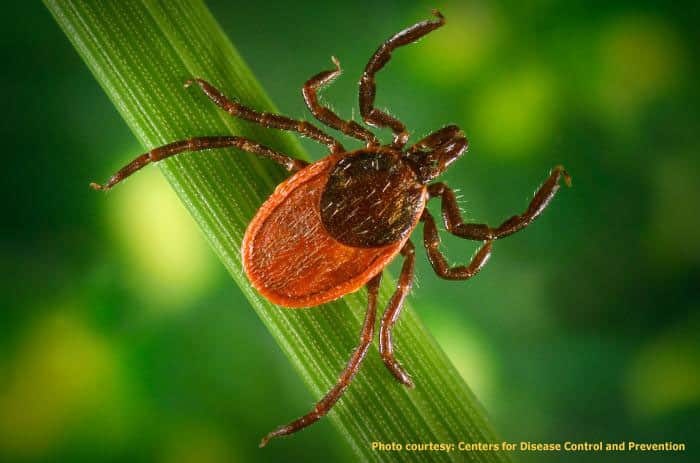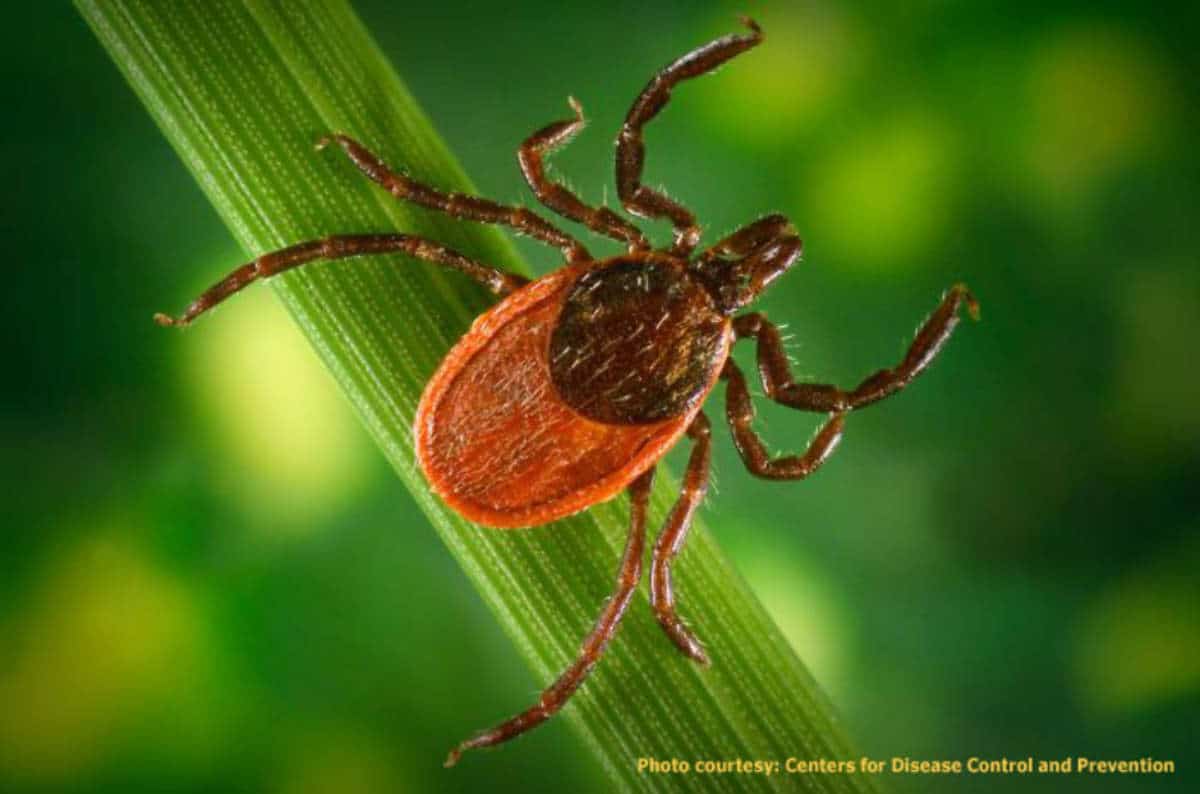Disclosure: This content may contain affiliate links. Read my disclosure policy.
Tick season in New York technically begins mid-March but it really kicks off in April. Warm overnight temperatures and receding snow signal the beginning of spring — and ticks are ready to party.
Ticks are small, blood-sucking parasites commonly found in grassy and wooded areas. There are several species of ticks in the Catskills and Adirondacks, but the one most responsible for transmitting Lyme disease is the black-legged tick, also known as the deer tick.
Tick season in New York includes the warmer months, from April to September. They’re found not only in the wilderness but can also be present in suburban areas and backyards. It’s essential to familiarize yourself with tick habitats and behavior to minimize the risk of tick bites.
Google searches for “tick bite” peak in the last week of May but, really, ticks are a serious problem spring, summer and fall.
Until the winter snow knocks them out and covers them up, you need to be prepared before you head outdoors. Here’s what you need to know…
Get access to hyper-detailed trail guides, insider tips, and expert advice. Join a vibrant community of like-minded hikers, receive exclusive content, and embark on unforgettable outdoor adventures. Whether you’re a seasoned outdoor enthusiast or just starting out on your hiking journey, this website provides invaluable resources to help you explore the best trails in the Catskills, Adirondacks, Hudson Highlands, Berkshires, and beyond. Get access now to all content on this website instantly and enjoy unique supporter benefits.
BTW, you might also enjoy…
- ADK › Whiteface Mountain via Marble Mountain
- DANGER › 6 Feet Under? How Our Adirondack Hike Turned Deadly Serious (Substack)
- ADK › Hurricane Mountain Fire Tower
- CATSKILLS › Catskills Fire Tower Challenge 2025
- Follow › My Instagram @TotalCatskills
- Follow › My writing for Times Union
Ticks & Lyme Disease
Commonly known as deer ticks, black-legged ticks transmit Lyme disease, Powassan virus and other infections.
Lyme disease is a bacterial infection caused by the bite of an infected deer tick. Lyme disease can cause a number of significant health problems. Antibiotics helps infected hosts recover rapidly and completely, but only if administered in the early stages of the infection.
Ticks can attach to any part of the human body but are often found in hard-to-see areas such as the groin, armpits, and scalp. In most cases, the tick must be attached for 36-48 hours or more before the Lyme disease bacterium can be transmitted. Only infected ticks transmit disease and not all ticks are infected. (Source: Fairfax County / CDC.)
Ticks can be very small and difficult to spot, especially during their nymph stage. Many people don’t realize they have a tick on them until they scratch and feel an engorged foreign body on their skin.
Tick Season in New York
Now for some good news: I’ve been hiking in the Catskills basically every week since 2018 and I have not once found a single tick on my body.
Sometimes, people do find ticks on themselves after a hike but the number seems very low — especially considering how busy our trails have become in recent years.
My theory is that, in New York, ticks are not so numerous on mountain hiking trails, and are more or less non-existent on upper elevations. Their main vectors — deer, rodents and birds — tend to roam lower down, and many of those creatures are most numerous in and around urban and suburban areas.
However, an Instagram follower commented on this post that he does indeed find ticks on himself weekly after off-trail hiking, both down low and up high. For sure, bushwhacking will expose you to literal brushes against vegetation, which is where ticks like to park themselves.
I bushwhack too. Not a ton, but some. And on marked trails, your potential exposure is always far lower. Again, I’ve brought home zero ticks from the Catskills. YMMV.
Here, I should stress that I’m not an epidemiologist, or a tick habitat expert. I’m just a person with a hiking website.
I also take a ton of precautions…
Tick Prevention: Physical
The five best physical things you can do to reduce your chances of getting bitten during tick season in New York are as follows:
- Stay on marked trails — this keeps you out of tall grass and the like, where ticks like to hang out and grab onto you as you brush past;
- If you‘re wearing long pants, tuck the cuffs into your socks — this prevents the ticks from crawling up your legs into your disco district;
- Wear light-colored clothing — so you can see the little fuckers when they crawl on you;
- Check your entire body carefully after spending any time where ticks might have been;
- Shower within two hours of returning from your hike to wash off any unattached ticks and to perform a thorough tick check
If you do find a tick, crush it and flush it. No mercy.
And remember, any time the temperature is above freezing, is tick season in New York — ticks don’t care about our human calendar.
Tick Prevention: Chemical
There are a number of excellent chemical treatments, easily findable online or in your local pharmacy or sporting goods store.
Repellent
I swear by Repel® Outdoor Insect Repellent which you can find easily online. It’s a Deet-free, non-toxic repellent made from oil of lemon eucalyptus. Helpfully, it also keeps mosquitos and black flies at bay.
Each application lasts about 6 hours — less on sweaty days — so you do need to reapply on longer hikes. But the bottles are small and fit snugly in a small backpack side-pocket.
I spray all exposed skin (arms, neck, head, lower legs) and even my cap, if I’m wearing one.
A friend recently recommended Nantucket Spider Extra Strength Repellent Spray. She says Repel doesn’t work well for her, but swears by Nantucket’s stuff.
Other people prefer a Deet-based solution like Off! repellent, and that’s fine too.
As with all solutions, YMMV. Experiment with several products to see which works best for you.
Insecticide
For clothing, I spray everything with permethrin. This includes: pants, socks, teeshirts and caps — but also my hiking boots, backpack and gaiters.
Permethrin is non-toxic to humans and breaks down in the environment relatively quickly. However, insects can’t break it down quickly enough before it destroys their nervous system. Basically, as soon as a tick crawls on your permethrin-treated clothing, it starts to die.
Each permethrin application lasts several washing cycles. Even during peak tick season in New York, I only reapply every 4-6 weeks.
Be aware that cats are more sensitive than dogs to permethrin, so keep those permethrin-treated clothes away from your feline besties.
Tick Season in New York: Two Solutions
This double-layer of repellent (to stop things from touching me) and insecticide (to kill anything that touches me) has kept me trouble-free for years.
- BTW, you may also find this post useful: Black Fly Bites.
Tick Removal
Removal can be tricky, especially with tweezers which be difficult to use on awkward-to-reach parts of your body. Using tweezers also runs the risk of breaking the tick which leaves its mouthparts intact. You don’t want that.
A tick twister tool, or a tick key tool which some people prefer, is your best bet. These tools slide right around a tick’s head and then you just pull gently until the tick releases.
The result is a perfectly neat extraction in seconds, with nothing left behind to infect you.
I keep a tick twister as part of my basic hiking gear in the first aid kit in my backpack.
This post is free to all readers thanks to my supporters. Get full access to this website today and enjoy great supporter benefits!
Tick-Removal After Care
After removing the tick, clean the bite area and your hands with rubbing alcohol, an iodine scrub, or soap and water.
Dispose of the tick by placing it in a sealed bag, wrapping it tightly in tape, or flushing it down the toilet. Never crush a tick with your fingers.
Tick Bite Treatment
If you do find a tick on your body, even if it’s engorged, don’t freak out. It needs to be on there for quite a while before it transmits any bacteria.
If you feel like the tick has been on you longer than you’re personally comfortable with, first clean the bite mark with some alcohol.
Next, seal up the tick somewhere safe.
Then check with your doctor who may ask you to send the tick for testing.
Lyme Disease
Lyme disease is a bacterial infection transmitted by the black-legged tick. It can cause a range of symptoms, including fever, fatigue, muscle and joint aches, and swollen lymph nodes. If left untreated, the infection can spread to the joints, heart, and nervous system.
- Early symptoms of Lyme disease include a red, expanding rash called erythema migrans, which can appear at the site of the tick bite within 3-30 days. The rash may have a bull’s-eye appearance.
- If you experience any symptoms of Lyme disease or notice a tick bite, consult a healthcare professional immediately. Early treatment with antibiotics is crucial for a full recovery.
- To prevent Lyme disease, follow the tick bite prevention tips mentioned earlier in this post, and be vigilant about checking for ticks during and after your hikes.
Tick Control for Dogs
Don’t forget that your dog needs protection too. Ticks love dogs and your dog will bring many, many ticks home.
Common solutions include Frontline, Advantix, and PetArmor and NexGard which is administered orally. Some dog owners prefer an option like a Seresto collar.
Warning: in all cases, monitor your dog for adverse reactions to any new chemical treatments, especially in the first 24 hrs.
When I last had a dog, and we had a small flea infestation at home, I jumped on it with Vet’s Best Flea & Tick Home Spray which worked wonders on the couch where they had taken up residence.
BTW, if you’re hiking with your dog in warm weather, check out How to Hike Your Dog Safely When It’s Hot & Humid.
Debunking Common Myths about Ticks and Lyme Disease

Myth 1: All ticks carry Lyme disease
Fact: Only black-legged ticks (deer ticks) are known to transmit Lyme disease. However, other ticks can carry different diseases, so it’s essential to protect yourself from all tick bites.
Myth 2: You can feel a tick bite
Fact: Ticks have a numbing agent in their saliva, making their bites painless. This is why it’s crucial to check your body for ticks regularly during and after your hikes.
Myth 3: Lyme disease always causes a bull’s-eye rash
Fact: While the bull’s-eye rash is a common symptom of Lyme disease, it doesn’t occur in every case. Some people may develop a different type of rash or none at all. It’s essential to be aware of other Lyme disease symptoms and seek medical advice if you suspect you’ve been bitten by a tick.
Myth 4: Ticks can jump or fly
Fact: Ticks cannot jump or fly. They crawl onto their hosts from grass, leaves, or other surfaces when a host brushes against them.
Get access to hyper-detailed trail guides, insider tips, and expert advice. Join a vibrant community of like-minded hikers, receive exclusive content, and embark on unforgettable outdoor adventures. Whether you’re a seasoned outdoor enthusiast or just starting out on your hiking journey, this website provides invaluable resources to help you explore the best trails in the Catskills, Adirondacks, Hudson Highlands, Berkshires, and beyond. Get access now to all content on this website instantly and enjoy unique supporter benefits.
Additional Resources
For more information on ticks, tick-borne diseases, and prevention, check out the following resources:
- Centers for Disease Control and Prevention (CDC) – Ticks: https://www.cdc.gov/ticks/
- New York State Department of Health – Ticks and Lyme Disease: https://www.health.ny.gov/diseases/communicable/lyme/
- American Hiking Society – Tick Safety: https://americanhiking.org/resources/tick-safety/
Frequently Asked Questions
When is tick season for dogs?
Tick season for dogs is the same as for humans: Any time the temperature is above freezing, ticks can move around. Typically, this is mid-March until the big freeze settles in during late fall and winter.
Where are ticks found on humans?
They often latch onto humans as we walk through vegetation, typically on legs and arms. But they are crawlers and will move around undetected until they find a good spot to attach. So they can be found anywhere on your body, on smooth or hairy parts.
A thorough check after a hike means visually checking yourself in a mirror, where you can, asking a loved one to check where you can’t, and/or feeling your skin and behind hairlines to sense an attached tick.
When are ticks out of season?
In deep sub-freezing cold. That’s it. Otherwise, it’s always tick season in New York.
Even in January and February, on day when temps get above freezing, it’s wise to be extra careful and to check yourself after any outdoors activity.
Further Reading on Tick Season in New York
Ticks and Lyme disease are significant concerns for hikers in the Catskills and Adirondacks. By understanding tick behavior, practicing effective prevention techniques, and knowing how to identify and remove ticks, you can minimize your risk and enjoy your outdoor adventures safely. Stay informed, stay vigilant, and happy hiking!
- Consumer Reports: When Does Tick Season Start?
- Department of Health: Be Tick Free – A Guide for Preventing Lyme Disease
- Wikipedia: Ixodes scapularis
- Photo Credit: Fairfax County / CDC
Read More
Get full access…
Get instant access to the full version of this site and enjoy great supporter benefits: full galleries, full trail notes, early access to the latest content, and more.
Hot on the website right now…
Follow for more…
Follow my @TotalCatskills content on Instagram for regular hiking inspo and safe, inclusive community.

